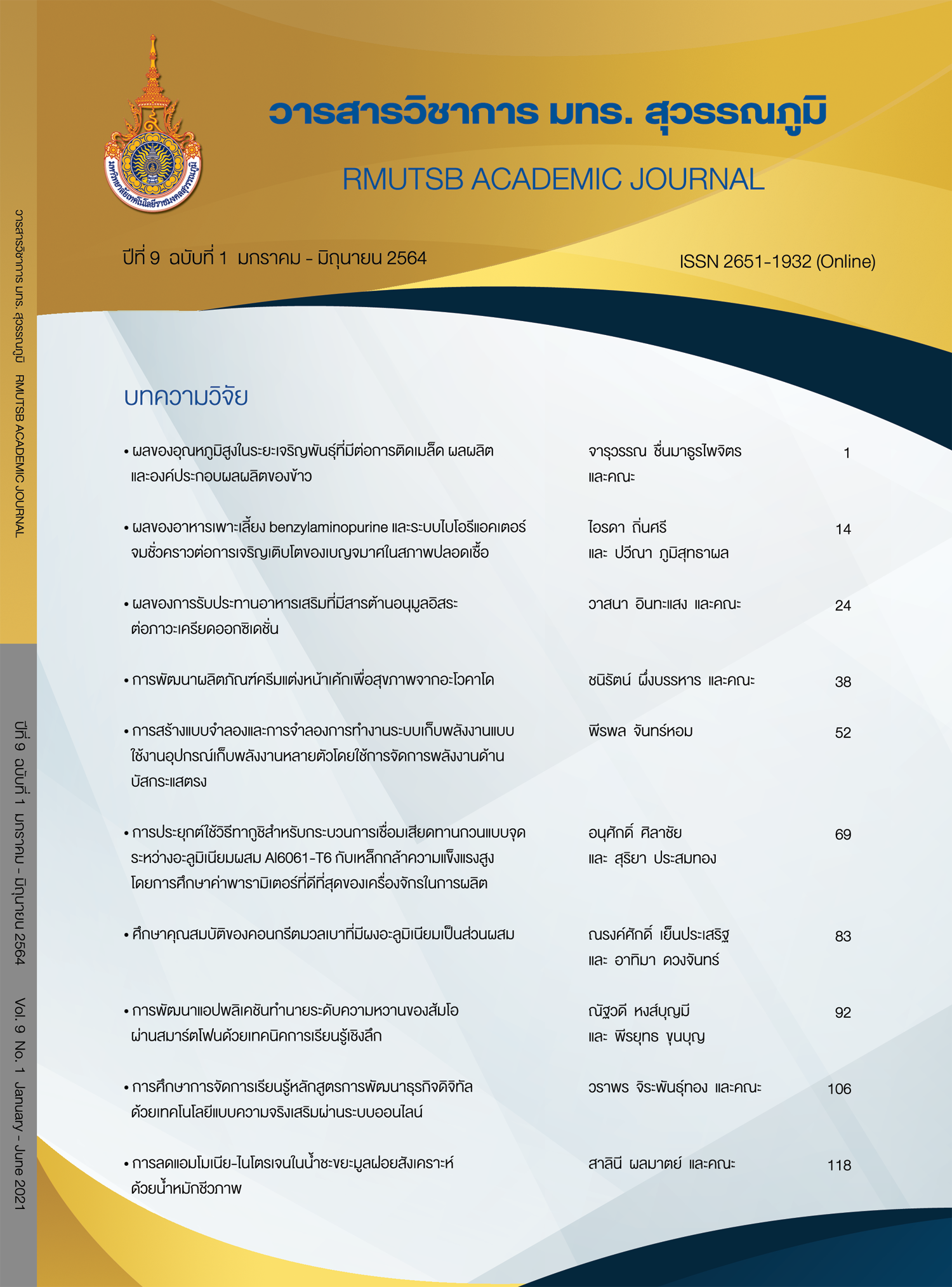A study of learning of digital business development with augmented reality technology via online system
Main Article Content
Abstract
Nowadays, many educational approaches have been evolved and also applied with emerging digital technology. The educational approaches have been developed along with the requirements of social issues such as travel difficulties, time management, and lessons reviewing. Moreover, the requirements include the situation of the global epidemic. The requirements of online learning therefore increase to reduce these problems. This research focused on an online learning method via a program which supports two-ways communication during teaching between instructors and students. It was compared with another online learning method via videos. The method allowed students communicating with their instructors after finished learning through social medias provided by the instructors.
In this research, the researchers developed an experimental study consisting of experimental and control groups. In conducting research, students of two groups learnt and participated through provided online systems as the experiment design. Two groups were subjected to online learning via zoom program and video, and each group consisted of 18 students. The course included 3 days and 7 hours a day. The students in two groups had been given the same materials and assignments. Researchers had conducted research tools to be consistent with the research objectives. The results showed that the achievement of online learning via zoom program and video was found slightly different. The average score of the experimental group was 14.93 points whereas of the control group was 12.80. The attitudes test towards learning of the experimental group was 90.87 and of the control group was 82.13. The statistical t-test was found that attitudes towards online learning by using zoom program were significantly higher than those of online learning with video at 0.05 significant level.
Article Details
Published manuscript are the rights of their original owners and RMUTSB Academic Journal. The manuscript content belongs to the authors' idea, it is not the opinion of the journal's committee and not the responsibility of Rajamangala University of Technology Suvarnabhumi
References
Allen, I. E., & Seaman, J. (2010). Class differences online education in the United States, 2010. Retrieved November 13, 2020, from http://www.onlinelearningsurvey.com/reports/class-differences.pdf
Allen, I. E., & Seaman, J. (2013). Changing course: Ten years of tracking online education in the United States. Newburyport, MA: Sloan Consortium.
Bangert, A. W. (2008). The development and validation of the student evaluation of online teaching effectiveness. Computers in the Schools, 25(1), 35-47.
Bolliger, U. (2004). Key factors for determining student satisfaction in online courses. International Journal on E-Learning, 3(1), 61-67.
Bonwell, C. C., & Eison, J. A. (1991). Active learning: Creating excitement in the classroom. Washington, DC: Education Resource Information Center (ERIC).
Cai, S., Chiang, F. K., & Wang, X. (2013). Using the augmented reality 3D technique for a convex imaging experiment in a physics course. International Journal of Engineering Education, 29, 856-865.
Cai, S., Wang, X., & Chiang, F. K. (2014). A case study of augmented reality simulation system application in a chemistry course. Computers in Human Behavior, 37, 31-40.
Carmigniani, J., Furht, B., Anisetti, M., Ceravolo, P., Damiani, E., & Ivkovic, M. (2011). Augmented reality technologies, systems and applications. Multimedia Tools and Applications, 51, 341-377.
Chastine, J., Nagel, K., Zhu, Y., & Yearsovich, L. (2007). Understanding the design space of referencing in collaborative augmented reality environments. Proceedings - Graphics Interface (pp. 207-214). New York: Association for Computing Machinery.
Demirci, C. (2017). The effect of active learning approach on attitudes of 7th Grade students. International Journal of Instruction, 10(4), 129-144.
Dziuban, C., & Moskal, P. (2011). A course is a course is a course: Factor invariance in student evaluation of online, blended and face-to-face learning environments. The Internet and Higher Education, 14(4), 236-241.
Koc, N., & Çelik, B. (2015). The impact of number of students per teacher on student achievement. Procedia - Social and Behavioral Sciences, 177, 65-70.
Milgram, P., & Kishino, F. (1994). A taxonomy of mixed reality vistual displays. Institute of Electronics, Information, and Communication Engineers Transactions on Information and Systems, E77-D(12), 1321-1329.
Milgram, P., Takemura, H., Utsumi, A., & Kishino, F. (1994). Augmented reality: A class of displays on the reality virtuality continuum. SPIE Proceedings Vol. 2351: Telemanipulator and Telepresence Technologies (pp. 282-292). Boston: Photonics for Industrial Applications.
Milgram, P., Drascic, D., Grodski, J. J., Restogi, A., Zhai, S., & Zhou, C. (1995). Merging real and virtual worlds. Proceedings of IMAGINA '95 (pp. 218-230). Monte Carlo: Institut national de l'audiovisuel (INA).
Niemi, H., & Nevgi, A. (2014). Research studies and active learning promoting professional competences in Finnish teacher education. Teaching and Teacher Education, 43, 131-142.
Rubin, B., Fernandes, R., & Avgerinou, M. D. (2013). The effects of technology on the community of inquiry and satisfaction with online courses. The Internet and Higher Education, 17, 48-57.
Swan, K. (2003). Learning effectiveness: what the research tells us. In J. Bourne & J. C. Moore (Eds.), Elements of quality online education, practice and direction (pp. 13-45). Needham, MA: Sloan Center for Online Education.


